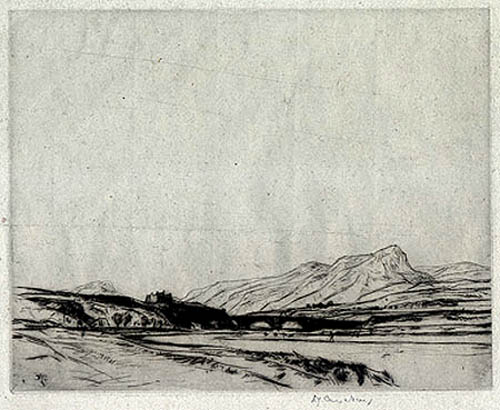| Title: |
Ralia |
| Artist: |
Cameron, Sir David Young 'D. Y. Cameron' (Glasgow, 1865 - 1945) |
| Date: |
1912 |
| Medium: |
Original Drypoint Engraving |
| Note: |
Sir David Young Cameron (D. Y. Cameron): Rightly regarded as one
of the greatest masters of the British school of landscape and architectural
etching, David Young Cameron started his career in business while studying
part-time at the Glasgow School of Art. He abandoned his career in commerce
at the age of twenty and produced his first etching two years later. By
the time he created his last etching (1932), Cameron had left an oeuvre
of exactly 500 works of art, many of which are now considered as masterworks
of original graphic art. David Young Cameron was a full member of the
Royal Academy, the Royal Scottish Academy and the Royal Engravers. He
was also knighted for his contribution to British art. |
| |
Most of Cameron's early works of art, committed purely in
etching, depict Scottish scenes. From 1892 to 1909, however, he frequently
visited the Continent and created many views in Holland, France, Italy
and Egypt. After 1911 Cameron again almost entirely devoted his art to
the Scottish landscape. Yet, unlike his earlier views, the medium he chose
was drypoint, with its rich, tonal contrasts and deep, velvety lines.
Kenneth Guichard writes, "It has been considered by some that Cameron's
greatest achievement as an etcher lay in the last Scottish drypoints.
... These last Scottish landscapes are not so much statements compelled
by passion as the result of quiet contemplation and a measured love."
* (Kenneth M. Guichard, British Etchers: 1850-1940, London, Robin
Garton Ltd., 1981, p. 32). |
| |
Although many fine reference books have been written upon
the etched art of D. Y. Cameron, confusion still prevails as to the edition
size of many of his plates. With the exception of a few, unsigned etchings
he submitted to arts periodicals like the Studio, almost all were
published in very small editions of twenty-five or less. This was particularly
true of the last drypoints, such as, Ralia, for unless the plate
is steel-faced, a drypoint will only yield a maximum of twenty satisfactory
impressions. Also, Cameron was a most meticulous artist. Many of his etchings
and drypoints exist in a number of states, which were printed in only
one to five impressions for each alteration to the plate. Ralia
is known to exist in at least five states and in all probability less
than five impressions were printed for every state. |
| Raisonne: |
Frank Rinder, D. Y. Cameron. An Illustrated Catalogue
of his Etchings and Drypoints, 1887-1932, Glasgow, 1932. Catalogue #433. |
| Size: |
4 1/2 X 5 3/4 (Sizes in inches are approximate,
height preceding width of plate-mark or image.) |
| |
Framed and Matted with 100% Archival Materials |
| |
View larger Framed Image |
| |
 |
| Buy Now |
Price: $495.00 US |
| Condition: |
Printed upon toned, antique laid paper and with full margins
as printed in Glasgow in 1912. Signed by Cameron in the plate with his
monogramme (lower left corner) and in pencil under the plate-mark. Containing
a slight horizontal crease mark, else a superbly printed, early impression
and in excellent condition throughout. Ralia is a prime example
of the famous Scottish landscape art of D. Y. Cameron. |
| Important Information: |
The artist biographies, research and or information pertaining to all the original works of art posted on our pages has been written and designed by Greg & Connie Peters exclusively for our site, (www.artoftheprint.com). Please visit us regularly to view the latest artworks offered for sale. We will soon be posting an update of our most recent research and include the biographical and historical information pertaining to our next collection of original works of art created by artists throughout the centuries. We hope you found the information you were looking for and that it has been beneficial.
Our Gallery, (Art of the Print / www.artoftheprint.com) guarantees the authenticity of every work of art we sell 100%. Full documentation and certification is provided. We offer a wide selection of international fine art dating from the early Renaissance to the contemporary art period. |









![]()
![]() or
phone Greg & Connie (905) 957-6666
or
phone Greg & Connie (905) 957-6666